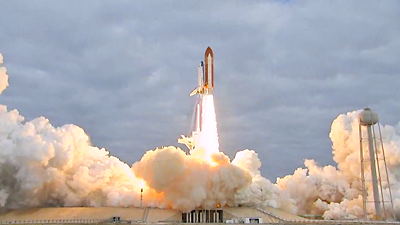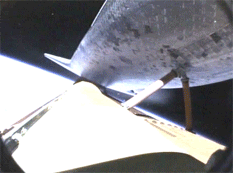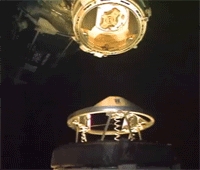Space Shuttle Endeavour launched on Monday 16th May 2011 from Kennedy Space Centre at first light of day. Within a few seconds she disappeared into the clouds in an uneventful flight into orbit.

 Mission STS-134 departed on board the Space Shuttle Endeavour early Monday morning. They plunged into the cloudy sky on their way to the International Space Station.
Mission STS-134 departed on board the Space Shuttle Endeavour early Monday morning. They plunged into the cloudy sky on their way to the International Space Station.
The remarkable departure was the culmination of a long process of preparations that included many delays, the latest lasting more than two weeks. All precautions were taken as everyone followed the wise words of NASA administrator Charles Bolden when he said “Stayed focused, particularly now that the programme is coming to an end.”
Endeavour is the second orbiter to be decommissioned after Discovery. The beginning of the final stretch of the 30-year shuttle programme lead by NASA. An emotional moment for the thousands of people committed to provide outstanding quality work at one of the best facilities in the world, which has become synonymous of excellence in science and education.

 Travelling vertically at 2000 km/h, by the time the spacecraft reached an altitude of 24km, it had lost half of its original 2000 tons of weight, solely by burning propellant at a rate of 5000 kg/sec.
Travelling vertically at 2000 km/h, by the time the spacecraft reached an altitude of 24km, it had lost half of its original 2000 tons of weight, solely by burning propellant at a rate of 5000 kg/sec.
Two minutes into the flight, the twin solid rocket boosters exhausted their fuel and separated from the spaceship to fall into the ocean. Relieved of their weight, Endeavour reached speeds of over 5000 km/h at an altitude of 59 kilometres.
Seven and a half minutes into the flight the mission reached 103 kilometres in altitude travelling at 21,700 km/hr, which generated 3G of gravitational force onto the ship and the crew. Shortly after reaching lower orbit the spacecraft separated from the orange external tank to continue its route to the ISS.


The Canadarm was essential in the inspection of the thermal protection system lining the underside of the shuttle. Particular attention was given to the leading edge of the wings and the nose-cap where the reinforced carbon-carbon panels are expected to be in perfect condition to protect the vessel from the tremendous heat generated by friction at re-entry.


 The mission
The mission
Mission 134, formed by Commander Mark Kelly, Pilot Gregory H. Johnson and Mission Specialists Mike Fincke, Greg Chamitoff, Andrew Feustel, and European Space Agency astronaut Roberto Vittori had a very busy schedule that required an extension to 16 days. They needed to coordinate sleep patterns to work more efficiently with their colleagues living at the ISS.
On the third day of the mission, the crew used the robotic arms to install the Express logistics carrier ELC-3 onto the space station. The next day was reserved for the AMS 2, also loaded in the cargo bay.
 One of the most important goals of this mission was to install the Alpha Magnetic Spectrometre (AMS 2) onto the ISS. A particle physics detector that will help advance studies of the origins of the universe searching for antimatter, dark matter and measuring cosmic rays. The program extends up to 18 years using the space station’s unique position as an observation post.
One of the most important goals of this mission was to install the Alpha Magnetic Spectrometre (AMS 2) onto the ISS. A particle physics detector that will help advance studies of the origins of the universe searching for antimatter, dark matter and measuring cosmic rays. The program extends up to 18 years using the space station’s unique position as an observation post.


The first spacewalk took place on day 5 when the astronauts retrieved ISS experiment material and secured it inside the cargo bay to return home.
On the sixth day of the mission, the crew of twelve on board the International Space Station got together in the Japanese module for a conference with the Vatican. They talked to Pope Benedict XVI, who in his address congratulated the crew for their courage and their work; an example of international collaboration for the common good. On the occasion the Pope also sent words of condolence to Paolo Nespoli for the loss of his mother, who passed away while he was at the space station.



On 23 May, Dimitry Kondratyev, Paolo Nespoli and Cady Coleman boarded the Soyuz TMA-20 module to return to Earth. They form the crew of Expedition 27, who for 6 months, called the space station "Home". As they left the station, Paolo Nespoli recorded invaluable images in video and still photographs of the Space Shuttle Endeavour docked to the International Space Station, which was practically complete. The astonishing pictures and video were made available to the public by NASA.

The three astronauts from Expedition 27 landed safely on the step of Kazakhstan. Unlike the Shuttle vehicles, the Soyuz uses a large parachute to slow-down its descent and fires its soft-landing engines as a final breaking manoeuvre when the capsule is a few metres above the ground. Additionally, the seats inside the capsule inflate to provide extra cushioning. Despite all efforts, the sudden deceleration is a tough experience when compared to landing on a runway.
The crew were met by a party from the Russian Space Agency, the European Space Agency and NASA. Following local tradition, they were extracted from the capsule and manually carried to their chairs. It usually takes four people to carry an astronaut, in the case of Cady Coleman, it took a single Russian official to carry her on his arms. A spontaneous gesture that brought a smile to those attending the event.




After their landing, the crew was flown to Karaganda to attend a traditional Kazakh welcoming ceremony. Astronaut Coleman and cosmonaut Kondratyev (Paolo Nespoli did not attend the ceremony) were given ceremonial coats and souvenirs commemorating their landing, those included a special edition of chocolates depicting Expedition 27, traditional Russian dolls featuring their faces, a golden figure of a deity riding a horse and a book about Yuri Gagarin and 50 years of space exploration.






Coleman mentioned that she was feeling “wobbly” after landing and needed assistance to walk on a straight line. In a later interview, Paolo Nespoli confirmed that the re-entry experience was tough, especially for him due to his stature and the extremely limited room inside the capsule. “The sudden effects of gravity feel as if you were lifting a 200 kg weight when attempting to move; on top of that, you have the vestibular symptoms that affect your balance.” All those effects are part of the normal process of re-adaptation following six months of life in space.
On a different note, Nespoli also commented that when he returned to his family, it took a moment for his 2 year old daughter to realize that “the person in front of her was the same that used to live inside the television screen,” as she only knew her father via teleconference for a quarter of her life.
 Meanwhile, at the ISS; the Orbital Boom Sensor System that was part of the Space Shuttle was transferred and installed onto the space station, changing its name to ISS Boom Assembly. Three additional space walks were conducted to complete repairs and maintenance and on mission day 12, the space station assembly was declared complete after 12 years of work. A pinnacle of human achievement with 15 countries working together for a common future.
Meanwhile, at the ISS; the Orbital Boom Sensor System that was part of the Space Shuttle was transferred and installed onto the space station, changing its name to ISS Boom Assembly. Three additional space walks were conducted to complete repairs and maintenance and on mission day 12, the space station assembly was declared complete after 12 years of work. A pinnacle of human achievement with 15 countries working together for a common future.
Endeavour also tested the STORRM (Sensor Test for Orion Relative Navigation Risk Mitigation) Navigation System that will allow future spacecraft park themselves. This means that docking and undocking will be safer and more reliable. This technology is based on high definition cameras aided by lasers and high-reflective markers controlling the flight with specialized software.
Night-Landing of Endeavour
Shortly after 2am on 1st June 2011, after flying 196 million kilometres (122 million miles) in 13 years of service, 25 challenging missions and 299 days in space, Space Shuttle Endeavour landed safely on a runway at Kennedy Space Centre. The orbiter that carried the first US assembly module to the ISS returned with its last mission STS 134, which completed the US contribution to the Station. Landing was uneventful in ideal weather conditions with very little tail wind.








After the routine check-ups, the crew emerged from the modified people transporter to do the traditional walk around the Shuttle, where they had the chance to greet and congratulate the ground crew and all the technical people that look after the vessel. In a short media conference, Commander Kelly talked about the great experience he shared with his colleagues during the mission. All the astronauts seemed to be in good spirit, only Greg Chamitoff required assistance walking about the landing strip. He did not join the crew at the post-landing debrief.
Space Shuttle Endeavour will be prepared to become a historical display vehicle at the California Science Centre in Los Angeles.




Endeavour
Shuttle Endeavour is the youngest of the vessels in the orbiter fleet. Originally delivered to KSC Shuttle Landing Facility in May 1991, it was built to replace Shuttle Challenger, which was lost to a launch accident in 1986. Her construction was an opportunity to implement many improvements, including:
- A 12 metre diameter drag chute to reduce the rollout distance by up to 600 metres.
- Plumbing and electrical connections improved to allow Extended Duration Orbiter missions of up to 28 days.
- Updated avionics with advanced computers, navigation system and controls.
- An improved version of the Auxiliary Power Units that operate the hydraulic systems.
 Endeavour was named through a national schools competition. The winners, Sanatobia Middle School in Mississippi, selected the name of the ship of illustrious 18th century British explorer Captain James Cook.
Endeavour was named through a national schools competition. The winners, Sanatobia Middle School in Mississippi, selected the name of the ship of illustrious 18th century British explorer Captain James Cook.
The HMB Endeavour, guided by Captain James Cook, left Plymouth on Aug. 26, 1768. The famous expedition travelled by way of the Madeira, Canary, and Cape Verde islands and Rio de Janeiro and rounded Cape Horn into the Pacific. Cook rediscovered New Zealand, originally discovered by Abel Tasman in 1642. Overall about 3,200 km (2,000 miles) of Australian coast was surveyed. Cook also confirmed the existence of a passage between Australia and New Guinea (the Torres Strait). By way of the Indian Ocean and the Cape of Good Hope, the explorers reached England on July 13, 1771.
Although Cook’s mission was to observe the transit of Venus, his unofficial secret orders were to claim the great south land of Australia for Britain. Cook was an unskilled writer but his journal, preserved at the National Library of Australia, describes his experiences and thoughts, including the near disastrous foundering of the Great Barrier Reef in 1770. He also mentions meeting Aboriginal Australians for the first time.
Congress woman’s visit to KSC
 Before the launch, the tradition is that astronauts have a meal with their families at Kennedy Space Centre. Their children write messages to their parents, which are framed and exhibited at the centre. Spouses exchange rings, usually worn by the astronauts in a necklace during the mission.
Before the launch, the tradition is that astronauts have a meal with their families at Kennedy Space Centre. Their children write messages to their parents, which are framed and exhibited at the centre. Spouses exchange rings, usually worn by the astronauts in a necklace during the mission.
Congress woman Gabrielle Giffords was present at KSC to see her husband Mark Kelly travel into space on this historic day.
On January 8, 2011, Giffords was shot outside a Safeway in northwest Tucson during her first “Congress on Your Corner” gathering of the year. At least nine others were injured when a man ran up to the crowd and began firing.
The Arizona Representative survived a life threatening bullet injury to the head. The progress since then has been understandably slow but promising. She underwent another operation on the first day of astronaut Kelly’s stay at the ISS.
Launch delays
Mission 134 was riddled with small problems that were found in time to delay launch. On 29 April everything was ready, even the astronauts were on their way to the orbiter on board the Astrovan when they heard: “Endeavour launch is scrubbed.” A failure of a heater circuit in an Auxiliary Power Unit meant that the mission had to be postponed.
The last launch of Endeavour was quite an occasion. The media was ready for a big day, even the folks from Spacevidcast were broadcasting live from KSC. In retrospect, there were signs of a scrubbed flight all along as "predicted by Ben's hair."


The initial four-day postponement was not enough as among other things, the external orange fuel tank had to be emptied in order to explore and fix the problem. In the end, it took more than 2 weeks for Endeavour to be ready. Everyone had to pack up and return on 16 May for the definitive launch.
References
¤ Dumoulin, J. (2005).’Endeavour (OV-105).’Kennedy Space Centre, NASA. [Online]. Available here. (Accessed: 16 May 2011).¤ ‘Di nuovo a Terra, Paolo Nespoli parla in conferenza stampa da Houston’ (2011). European Space Agency. [Online]. Available here. (Accessed: 09 Jun 2011).
¤ ‘Endeavour’ (2011). NASA. [Online]. Available here. (Accessed: 16 May 2011).
¤ ‘Endeavour blasts off for next-to-last shuttle mission’ (2011). CTV Ottawa. [Online]. Available here. (Accessed: 16 May 2011).
¤ Humphrey, M. (2001) ‘Captain James Cook.’ Coo-ee Australia Calling [Online]. Available here. (Accessed: 16 May 2011).
¤ ‘James Cook’s Endeavour journal’ (2011). National Library of Australia. [Online]. Available here. (Accessed: 16 May 2011).
¤ Kennedy, E. (2011). ‘John Gardner, marine artist.’ Scottishboating. [Online]. Available here. (Accessed: 16 May 2011).
¤ ‘Space Shuttle Endeavour’ (2011). ‘John Gardner, marine artist.’ Scottishboating. [Online]. Available here. (Accessed: 16 May 2011).
¤ ‘Station Flyers Mourn Death of Crewmate's Mom’ (2011). Florida Today. [Online]. Available here. (Accessed: 08 June 2011).
No comments:
Post a Comment